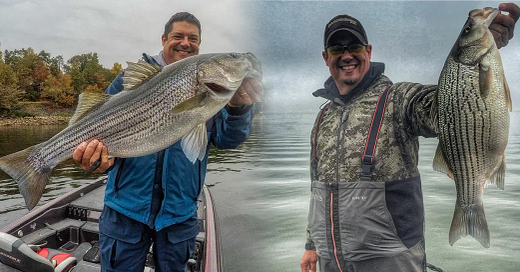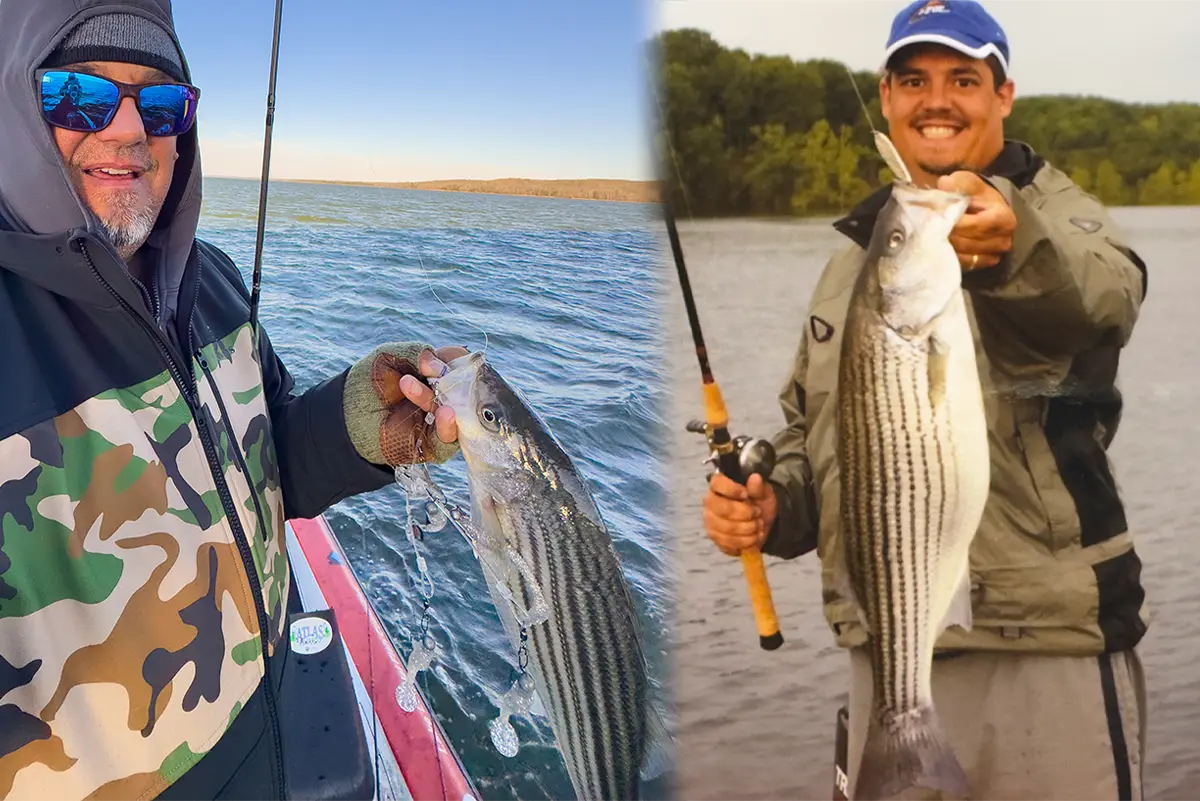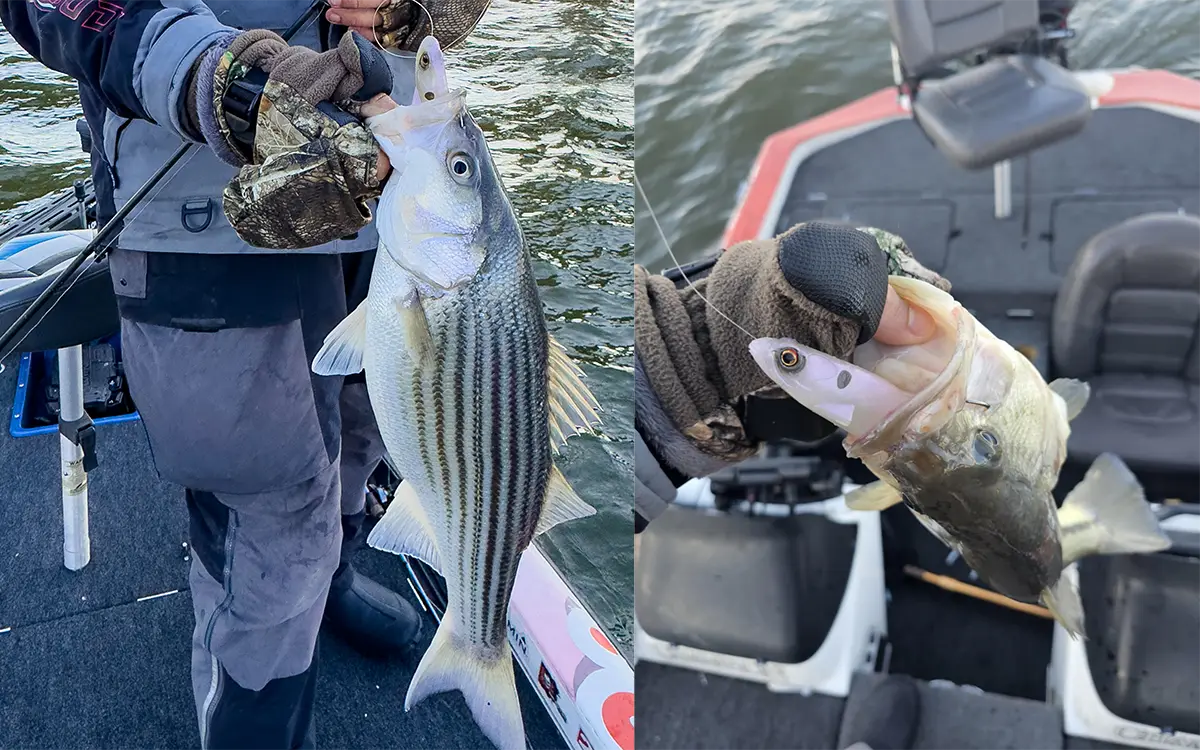How Stripers and White Bass Can Save Your Fishing in Late Winter
A great option for cold tough conditions is fishing for stripers and white bass
I don’t fish for stripers and white bass as much as I used to, but they sure do save some tough winter days of fishing. When the water temps get in the low 40s or colder, fishing gets pretty tough for most gamefish. But thankfully for us anglers that still want to brave the elements in the dead of winter, the white bass family of fish offers some fast action in cold weather.
It seems where I live, January, and sometimes February, can be the hardest months to fish because of battling frozen ramps, ice in places, dirty water from snow runoff and really cold temps that keep the fish from moving much or being very easy to pattern as they just won’t respond to many lures in frigid water temps.
But you can still pattern and find willing participants if you change your tactics and chase stripers, white bass and hybrids in the winter. One of my close friends actually looks forward to this time of year in Georgia because the stripers group up en masse and he can absolutely pound them with jigging spoons. And since they love to cook stripers for fish tacos and blackened fish, he is often found filling coolers in the late winter before most of us turn our attention to their black bass cousins, crappie and other gamefish in the spring.
WHERE I LOOK FOR STRIPERS AND WHITES IN THE WINTER
I’m usually targeting stripers on the main river of a big reservoir or riverine fishery. So most of my advice is geared towards those types of fisheries. When I lived in Arkansas, I targeted stripers in the winter on lakes like Beaver and Ouachita. I have caught them for many years, and most of the time it’s just understanding their seasonal migrations just like any other fish.
In the winter, they have tendency to really gang up in places just out of the current. Something that obstructs the current like a point, a high spot, a riprap wall, a bridge piling can all group stripers up. They want to be in deep water where the shad are really dense. And generally speaking the shad group up in those same places to avoid having to move much.
Most of the time it’s a high spot that has deep water behind it out of the current. Like say where a creek channel dumps into a river channel. Or it can have current too, but has things like big structures or rocks that obstruct the current, congregate bait and congregate the shad. A lot of times, the big groups will just be out in open water, but it’s usually water just out of the flow of the main current.
So I look at a map and find a lot of deep pockets of water near the main river behind a high spot. If you’re a good ledge fishermen, you’re looking for drops away from the current instead of facing into the current like you normally seek when bass fishing in the summer.
LURES FOR WINTER STRIPES
Early on, I would go fishing for stripers with other anglers and guides trolling umbrella rigs. After I started to understand what stripers and whites did in the winter, my approach went more towards vertical jigging for them with jigging spoons. This was back before there were swimbaits, side imaging and live sonar. All we had was 2D sonar. And the great thing about stripers comes in the fact that they group up in large groups that you can easily find with regular old sonar.
Once swimbaits came out and then castable umbrella rigs, that became my bait of choice for stripers. A swimbait mimics a big shad like a striper wants to eat maybe better than any other bait. And you can control the depth and speed easily.
You can stay off of them and cast swimbaits or Alabama rigs. If they are deep enough, you can get over them and snap a jigging spoon in and around them. A big flutter spoon also works well as does a big feathered hair jig. And a blade bait is another good option for both casting and vertical jigging.
Trolling still works of course, but I don’t really consider trolling fishing, so I never mess with it.
You need stout line. I generally fish heavy action rods with 20-pound line. I don’t like braid for stripers because they pull really hard and can make your braid dig into the spool. I’ve landed stripers to 45 pounds on 20-pound fluoro, so I just stick with that.
WHITE BASS ACTIONS WORK BEST
White bass are a ton of fun to catch. They pull hard, are overly aggressive and react to flash and violent movement. That just makes them a fun fish to me. On Kentucky Lake, some local lure builders make 3/4-ounce inline spinners that are killers for big white bass. And a blade bait is really hard to beat as well.
It’s a simple rip and let fall to the bottom and rip again retrieve with both lures. In the winter, your rip might just be a hard slow pull that makes the blade spin or the bait vibrate and then let it fall on semi-slack line.
RECENT TRIPS
We got on a great striper bite recently for those good eater sized stripers in the 3 to 8-pound range. We found them roughly 20-30 feet deep on high spots that dropped off into the river channel. We would cast up into 18 or so feet of water with umbrella rigs or single swimbaits like the Bass Mafia Daingerous Swimbait Loaded Deep and the Megabass MagDraft Free Style.
We let the swimbaits sink to the bottom and then started a slow but steady retrieve, pausing occasionally to keep it close to the bottom the whole time. Stripers will suspend a lot, but we find them hunkered right on the bottom when the water is really cold or the current is running pretty hard.
It was cold enough that fishing without gloves was tough. And you wanted to keep your head and face covered because the cold wind and air immediately chapped the cheeks. Even still, we caught more than 2 dozen stripers and a bunch of nice white bass in less than favorable conditions when most people wouldn’t even go out.
And that’s why the winter white bass family get the nod for me. They saved the winter for me this past year. Because on the worst of days, they were patternable, aggressive and I never get tired of feeling that “thump” on a swimbait in deep water.
If you haven’t tried it before, it’s still pretty good in early March. And, as a bonus, if you like fish tacos or blackened fish, you’ll be hard pressed to find a better alternative than a well cleaned striper.







